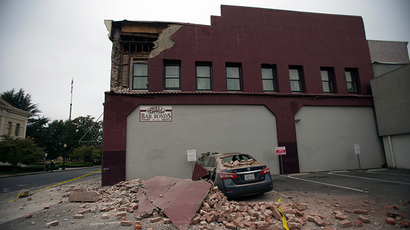Nearly half of US population live at risk of damaging earthquake - report

About 143 million Americans in the 48 contiguous states reside in areas vulnerable to earthquakes, with about nine percent, or 28 million, living in areas with a “high potential” for hazardous quakes.
Around 18 percent of Americans, or 57 million people, live in areas deemed "moderate" hazard zones, according to a new report published in journal Earthquake Spectra. The study utilized US Geological Survey data to predict which areas of the US were most at-risk.
Nearly Half of Americans Exposed to Potentially Damaging Earthquakes -almost double prev. est. http://t.co/anldAY516qpic.twitter.com/InM1SPd82V
— USGS (@USGS) August 10, 2015The numbers are nearly twice that of the latest estimate from two decades ago that found about 75 million people in 39 states were exposed to a possible damaging quake.
The increase is due to an uptick in overall US population and the further concentration of population in especially risky areas like California, according to Mark Petersen, co-author of the study and chief of the USGS National Seismic Hazard Modeling Project. Advanced research methods have also added more earthquake risks, including the Cascadia Subduciton Zone in the Pacific Northwest.
READ MORE:Smartphones could be used as earthquake early-warning systems
Much of the population facing mid- to high-risk lives in the area between the Rockies and the Pacific Ocean, with the California coast along the San Andreas Fault being the most likely to receive damage from a natural earthquake. An active fault in the northern Rockies, near Idaho and Wyoming, is also at risk of a quake with a magnitude as high as 7.5, scientists reported in 2010.
In the lower Midwest and upper South, the New Madrid Fault stretches from southeastern Missouri into Arkansas and Tennessee. Other states -- including Illinois, Indiana, Kentucky, and Mississippi -- could potentially feel the effects of a large quake.
Other high-hazard areas include eastern Tennessee, the Carolinas, and the Northeast, mainly northern New York near the Ramapo Fault. While these areas could get a damaging quake, "many of these places are not going to experience a rash of earthquakes," Petersen said, according to The Washington Post.
"There are places in the United States where we think ground shaking could be significant and we ought to look at those areas to see if they are built to the safe levels that would correspond to these ground shaking levels."
The report found that there is a "significant number of critical infrastructure facilities located in high earthquake-hazard areas."
Petersen added that it's "important that people who live in these areas understand they live in earthquake country and they need to understand that they should maybe prepare themselves."
The research team analyzed the risk of earthquakes within a 50-year timeframe.
READ MORE:Man-made earthquakes increasing in US, wastewater to blame – USGS
The report did not include information about earthquakes caused by human activity, such as those stemming from hydraulic fracturing, or fracking. To unleash oil or natural gas, fracking requires blasting large volumes of highly pressurized water, sand, and other chemicals into layers of rock.
States such as Oklahoma, Texas, Alabama, and Ohio have experienced a major increase in the incidence of minor earthquakes that scientists have attributed to modern fracking operations.














